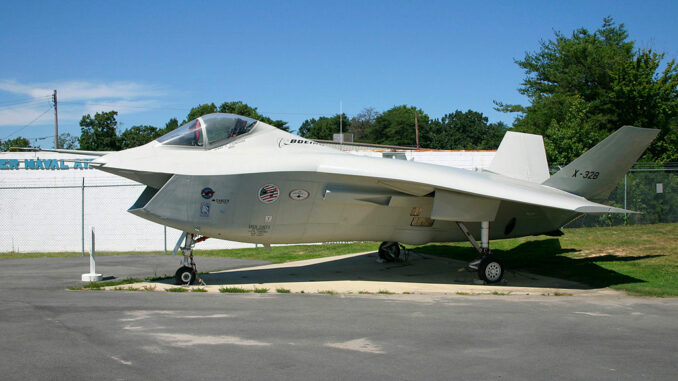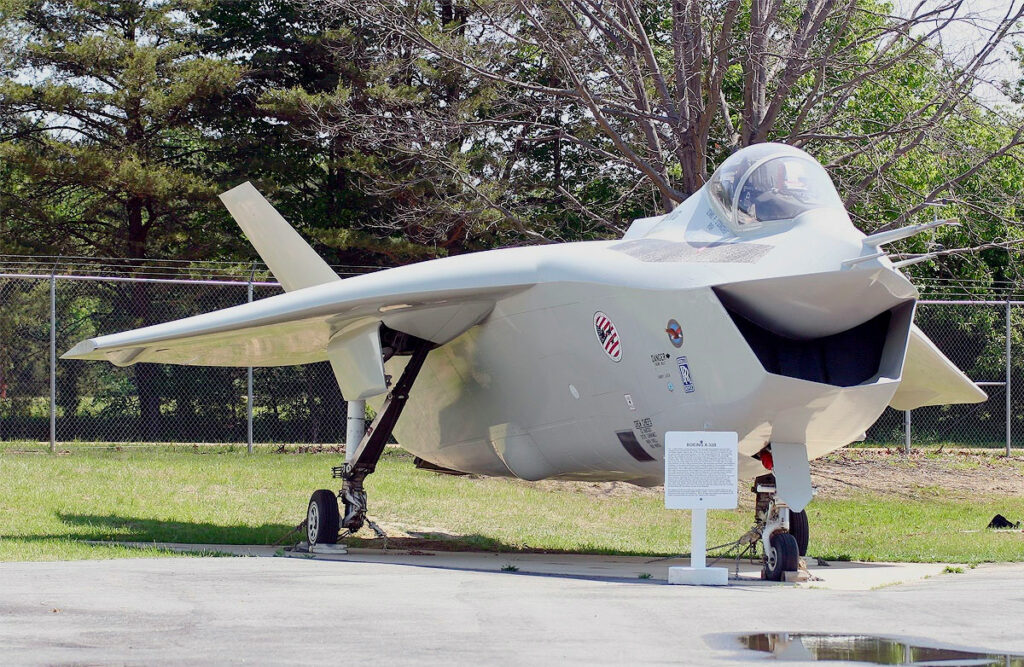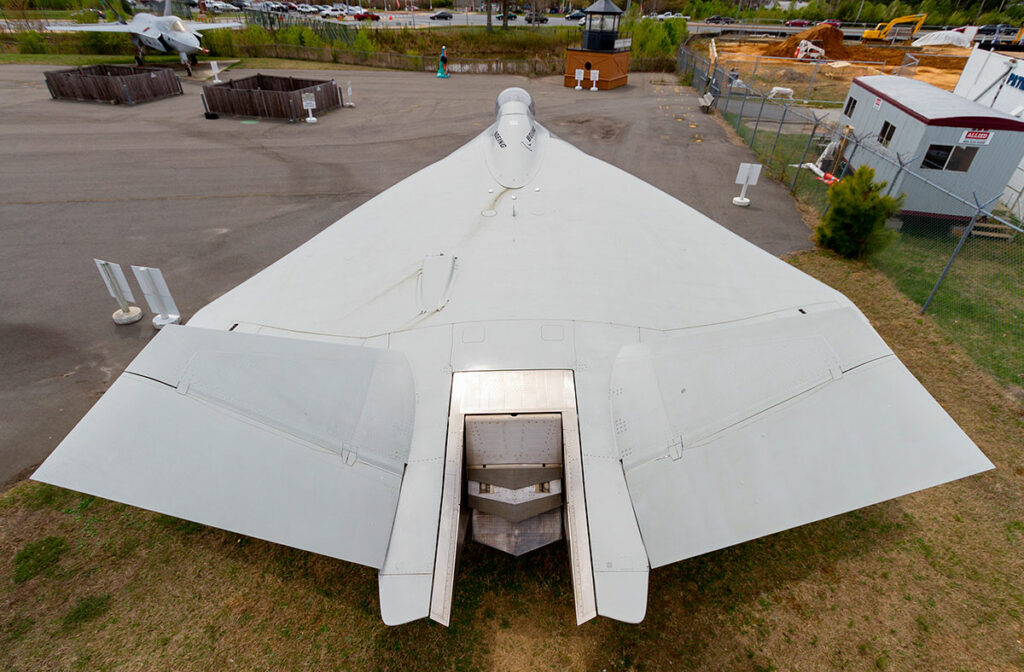
Discover the four technical innovations of the Boeing X-32, from direct lift to monocoque composite, cost-oriented design and stealth compromises.
Summary
The Boeing X-32 project, which competed in the Joint Strike Fighter (JSF) program in the United States, is based on four major technological innovations. First, the direct-lift solution in its STOVL version, designed to simplify the vertical propulsion system. Second, its carbon monocoque delta wing, designed to reduce manufacturing costs and increase internal capacity. Third, an integrated design philosophy focused on cost reduction and commonality between variants. Finally, the aircraft incorporates distinctive aerodynamic and stealth features, including an “alligator mouth” air intake and minimalist tailplane, which illustrate the technological compromises. Although the X-32 did not win the JSF contract, its design remains a valuable source of information for combat aircraft.

The innovation of direct lift in the STOVL version
One of the most spectacular aspects of the Boeing X-32 is its STOVL (Short Take-Off and Vertical Landing) version, known as the X-32B, which uses a direct lift (“direct lift thrust vectoring”) rather than a lift fan system like that of the Lockheed Martin X-35 or the future F-35B.
Mechanism
In this architecture, the Pratt & Whitney F119-PW-614S main engine is mounted far forward, just behind the cockpit. This layout helps to shift the center of gravity forward and make hover and supersonic flight compatible. The thrust flow exiting the afterburner nozzle is redirected for vertical landing by a two-position butterfly valve that directs the flow to three vector nozzles:
- A large central nozzle for pitch control during lift.
- Two smaller nozzles, near the wing tips, for roll control, fed by secondary pressure ducts (bleed air) from the engine.
Mitigation of hot gas ingestion
A major challenge of the direct-lift system is the re-ingestion of hot exhaust gases into the engine intake (Hot Gas Ingestion – HGI), which can cause a “pop stall” (sudden loss of thrust). To counter this, Boeing has integrated a device called a “jet screen”: a screen of cold airflow (bypass or dedicated air intake) injected in front of the lift nozzle, creating an aerodynamic barrier between the hot air and the main inlet.
Performance and transition
Engine tests on the X-32B showed that the conversion between conventional flight mode and vertical lift took 1 to 3 seconds, demonstrating the degree of maturity achieved. Boeing announced that the X-32B and X-32A shared up to 90% of common propulsion components.
Analysis
This choice has advantages and disadvantages: mechanical simplicity (no additional fan, no drive shaft) allowed for a reduction in weight and costs. However, this configuration places a high thermal load on the engine and exhaust, and increases exposure to hot gas ingestion. Ultimately, although the innovation was real, it did not convince JSF decision-makers, who felt that the X-35’s fan configuration offered a better compromise for more efficient and stealthy STOVL.
Carbon monocoque delta wing and lightweight structure
Another important innovation of the Boeing X-32 is its delta wing, designed as a carbon fiber monocoque structure, molded in one piece. This approach was radical for a combat aircraft at that time.
Manufacturing, materials, and internal volume
Boeing designed the wing as a single composite entity, with modeled upper and lower skins, reducing the number of parts, assemblies, and assembly time. The “heavy tooling-free” assembly (using laser alignment and 3D simulation) reduced tooling costs by 60 to 70% compared to previous programs.
The wing profile, with its thick thickness combined with a 55° sweep leading edge, offered significant internal fuel capacity: up to 20,000 pounds (~ 9,100 kg) in the wing alone, improving endurance and range.
Integrated antennas and stealth
The thickness of the wing also made it possible to house antennas that conformed to the profile, reducing secondary radars and external protrusions, which was expected to improve radar signature and maintenance.
Analysis
This design shows that Boeing sought to push the limits of low-cost manufacturing while offering significant internal volumes. The challenge was to complete a single wing common to all variants (CTOL, CV, STOVL). However, this choice also brought aerodynamic compromises: the delta wing, although favorable for fuel mass and structural simplicity, proved to be less maneuverable according to the specifications for the naval aircraft, forcing Boeing to consider a version with a conventional tail.

Cost-oriented design and the search for commonality between variants
The third pillar of the X-32’s innovation lies in the overall approach adopted by Boeing: maximum commonality between variants and intensive use of digital modeling and virtual manufacturing.
Commonality and modularity
From the outset, Boeing positioned the CTOL, carrier-based (CV), and STOVL versions to share exactly the same airframe as much as possible, with identical delta wings and central structures. This was intended to reduce life-cycle costs for the four branches of the U.S. military (replacing the F-15/F-18, Marine Corps, Navy, and Air Force). This philosophy was more aggressive than that of Lockheed Martin.
Digital manufacturing and 3D simulation
The X-32 benefited from the systematic use of 3D solid modeling and virtual reality assembly simulation tools. These tools made it possible to validate the structural and manufacturing integration before “cutting metal.” This “lean design” approach reduced costs and implementation times. Boeing announced that the target empty weight was well below 11,000 kg (24,000 lb) for all versions.
Analysis
The industrial challenge was clear: to make the JSF family a uniform platform in order to reduce logistics, training costs, and spare parts. In the context of budget constraints in the 1990s, this innovation seemed appropriate. However, it required technical compromises (size, wings, tail) that ultimately weighed heavily in terms of increased performance requirements, particularly for the Navy.
Aerodynamic compromises, stealth, and their implications
Finally, the Boeing X-32 incorporated innovations in aerodynamics and stealth, but also compromises that proved critical.
“Alligator mouth” air intake and radar visibility
The forward positioning of the engine required a large air intake under the nose, often referred to as an “alligator mouth.” This configuration allowed the engine to be powered while stationary (hovering) without benefiting from the ram air flow. However, it provided a direct line of sight to the engine compressor, which is a major radar vulnerability (high radar return, high RCS). Boeing considered using variable baffles or shutters in the production version to mitigate this flaw.
Aerodynamics and minimalist tailplane
The delta wing without a horizontal tailplane—or with a radically simplified tailplane—reduced the number of moving surfaces, simplified manufacturing, and maintained commonality. However, as the Navy’s specifications evolved, it became apparent that this configuration limited maneuverability and effectiveness in naval operational conditions. Boeing had to consider a version with a conventional tailplane and a redesigned rear wing, which called into question the basic concept.
Analysis
These choices clearly illustrate the technical tension between low-cost manufacturing, multi-role capability, and high stealth and maneuverability performance. In the case of the X-32, the innovation is real—but the compromises are also clear. The massive air intake facilitated the STOVL solution, but penalized stealth. The delta wing simplified the structure and increased fuel capacity, but reduced maneuverability. The X-32 therefore remains a fine example of an industrial compromise that was implemented, but whose weaknesses were exploited in the final choice of the JSF contract.
Overall reflection
The Boeing X-32 was not selected for the JSF program—the Lockheed Martin X-35 won and became the F-35 Lightning II. However, studying the innovations of the X-32 provides several lessons:
- The direct lift approach is technically viable, but it imposes thermal, airflow, and design constraints that can become limiting when compared to more sophisticated solutions.
- The manufacture of large monocoque composite components is a major advantage in terms of costs and internal volumes, but must remain compatible with aerodynamic and operational interchangeability requirements.
- The concept of maximum commonality is appealing, but it requires that all variants (Air Force, Navy, Marine Corps) be served without major compromises in performance or naval ergonomics.
- Finally, stealth and maneuverability remain key criteria in the selection of next-generation fighters: structural innovation must therefore always be tactically and operationally viable.
Despite its status as a “forgotten” part of aviation history, the X-32 provided a rich platform for experimentation, and some of its technologies—particularly in composite manufacturing and digital modeling—were subsequently adopted or further developed. It therefore deserves to be analyzed not only as a “failure” in competition, but as a driving force for learning in modern combat aviation.

Sources
– Wikipedia: Boeing X-32, English and French versions.
– Boeing Media Room: “Boeing Completes First Phase of JSF X-32B Engine Runs,” September 23, 2000.
– Boeing Media Room: “Boeing Completes JSF X-32B Engine Accelerated Mission Tests,” January 15, 2001.
– National Interest: “Boeing’s X-32 Fighter Can Be Explained in 3 Words.”
– National Security Journal: “The Boeing X-32 Stealth Fighter Was ‘Fatally Compromised.’”
War Wings Daily is an independant magazine.